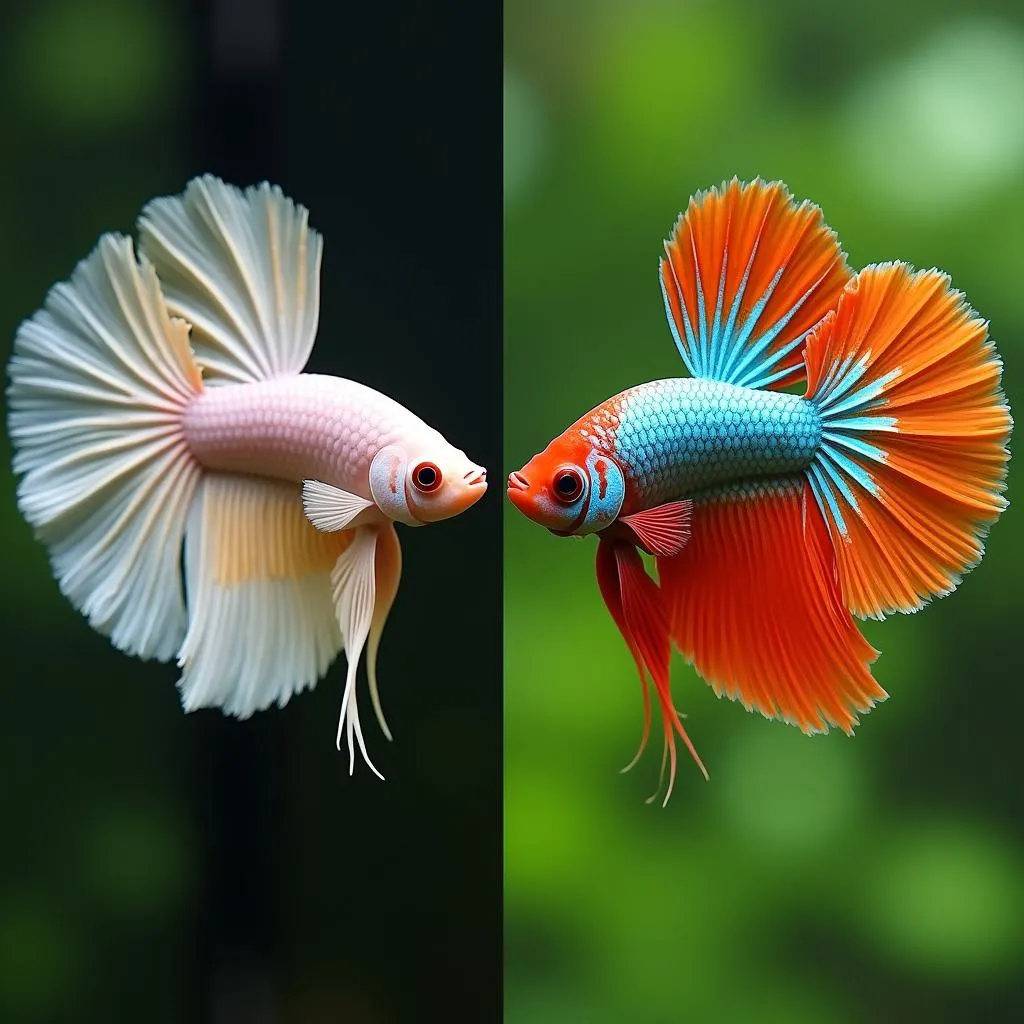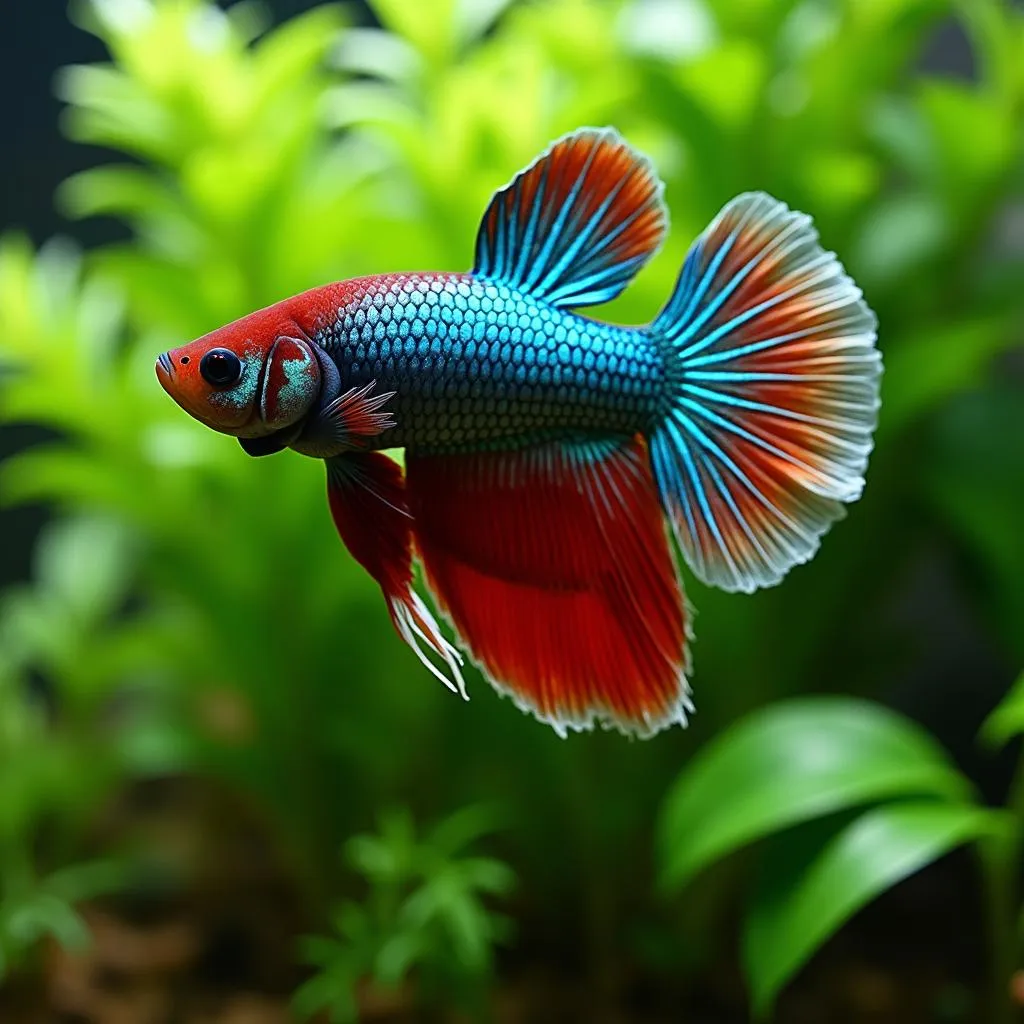Betta fish, also known as Siamese fighting fish, are renowned for their vibrant colors and flowing fins. Many betta owners wonder, “Do bettas change color?” The answer is a resounding yes! But the reasons behind these color changes are fascinating and diverse. Let’s dive into the captivating world of betta color transformations.
Understanding Betta Coloration
A betta’s color is determined by pigment cells called chromatophores located beneath their scales. These cells contain different pigments that reflect light, creating the array of colors we see. There are several types of chromatophores, each responsible for a specific color group:
- Melanophores: Produce black, brown, and gray pigments.
- Erythrophores: Responsible for red and orange hues.
- Xanthophores: Create yellow pigments.
- Iridophores: Don’t contain pigments but reflect light, producing iridescent and metallic sheens.
The interaction and distribution of these chromatophores determine a betta’s overall color and pattern.
Factors Influencing Betta Color Change
Betta fish possess the remarkable ability to change color throughout their lives. This dynamic transformation can be attributed to a combination of factors:
1. Age
Like many animals, bettas undergo color changes as they mature. Young bettas often display duller colors compared to their adult counterparts. As they grow, their chromatophores develop further, resulting in richer and more intense coloration.
 Young and Adult Betta Color Comparison
Young and Adult Betta Color Comparison
2. Genetics
Genetics play a crucial role in a betta’s color potential. Selective breeding has resulted in a vast spectrum of color variations, from solid hues to intricate patterns. Some color genes are dominant, while others are recessive. A betta’s genetic makeup ultimately dictates the range of colors it can express.
3. Environment
Environmental factors significantly influence betta coloration.
- Water Quality: Pristine water conditions are essential for vibrant colors. Poor water quality can stress bettas, leading to color fading or darkening.
- Lighting: Adequate lighting is crucial for betta color development. Low light conditions can cause their colors to appear dull.
- Substrate: Darker substrates can enhance a betta’s colors by providing contrast.
- Decorations: Plants, rocks, and caves offer hiding spots, reducing stress and promoting natural color vibrancy.
 Betta in a Planted Tank
Betta in a Planted Tank
4. Mood and Health
Believe it or not, a betta’s mood can affect its color! When stressed, frightened, or sick, bettas may experience color loss or darkening. This response is often temporary, and their colors typically return once the stressor is removed or they regain their health.
- Stress Stripes: Vertical stripes on a betta’s body, often accompanied by fin clamping, can indicate stress or illness.
- Marbling: A marbled appearance, where colors seem to blend or become patchy, can also signal stress or health issues.
5. Diet
A nutritious diet plays a vital role in maintaining vibrant betta colors. High-quality betta pellets, supplemented with occasional live or frozen foods like brine shrimp and bloodworms, provide the necessary nutrients to support color development.
 Betta Food Options
Betta Food Options
Do Black Bettas Change Color?
Black bettas are particularly intriguing when it comes to color change. While their base color is black, they can still experience subtle shifts in hue and pattern.
- Iridescence: Some black bettas possess iridophores that create a shimmering or metallic sheen, which can change depending on the lighting.
- Marbling: Black bettas may develop marbling patterns, where the black pigment mixes with other colors, resulting in a mottled appearance.
- Stress: Like other bettas, stress can cause black bettas to temporarily fade or display stress stripes.
Do black bettas change color? Explore this fascinating topic further to understand the unique ways black bettas can transform their appearance.
Can You Make a Betta Change Color?
While you can’t directly control a betta’s color-changing abilities, you can create an environment that encourages vibrant coloration.
- Maintain optimal water parameters.
- Provide adequate lighting with a day-night cycle.
- Offer a varied and nutritious diet.
- Minimize stress by ensuring a spacious tank with hiding places.
By following these guidelines, you can help your betta showcase its most stunning colors.
Can bettas change color? Discover more about the factors that influence betta color change and learn how to create the ideal environment for your finned friend.
Conclusion
Betta fish are truly captivating creatures, renowned for their ability to transform their appearance throughout their lives. By understanding the factors that influence betta color change, from genetics and age to environment and mood, we can better appreciate the complexities of these remarkable fish. Providing optimal care and a stimulating environment allows bettas to showcase their most brilliant and captivating colors.

